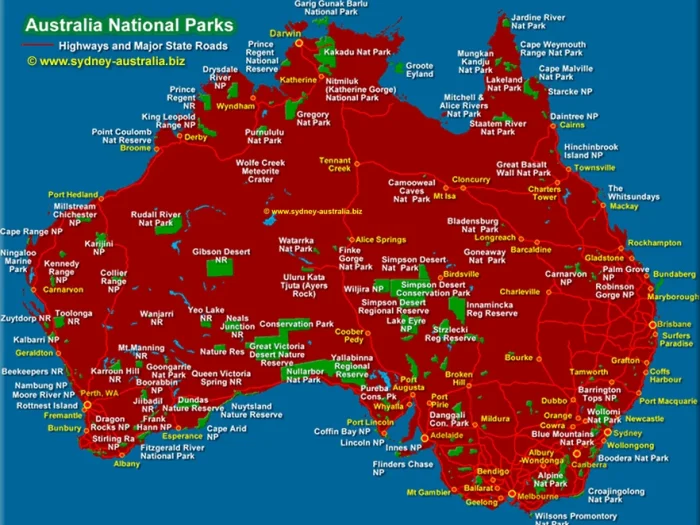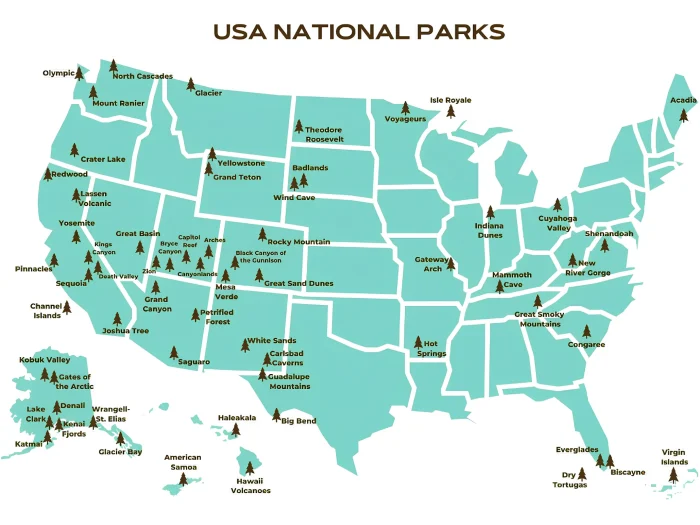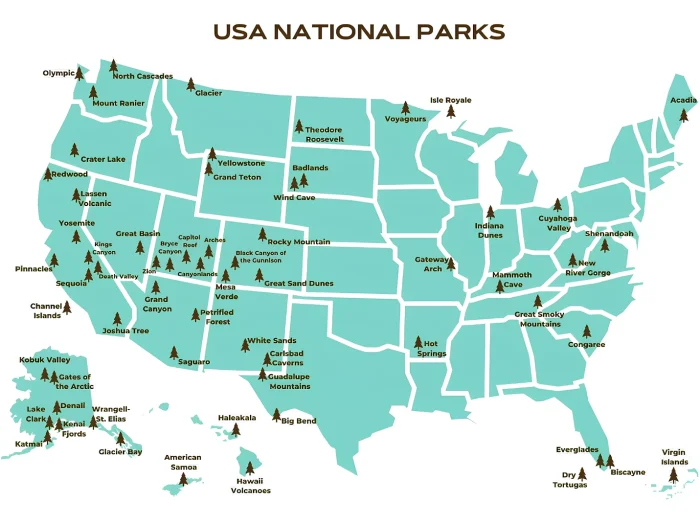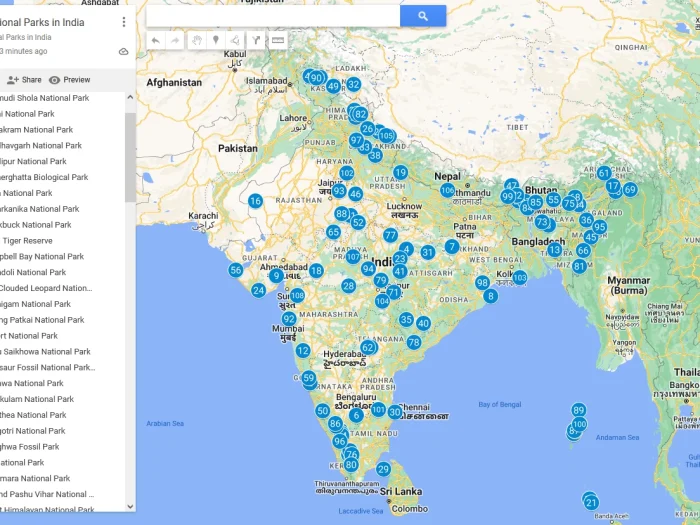List of National Parks in Hawaii
List of National Parks in Hawaii.
Hawaii has 8 National Parks:
- Haleakalā National Park
- Hawaiʻi Volcanoes National Park
- Honouliuli National Historic Site
- Kalaupapa National Historical Park
- Kaloko-Honokōhau National Historical Park
- Pearl Harbor National Memorial
- Puʻuhonua o Hōnaunau National Historical Park
- Puʻukoholā Heiau National Historic Site
(You can click the image below to see Hawaii national parks map in full size)
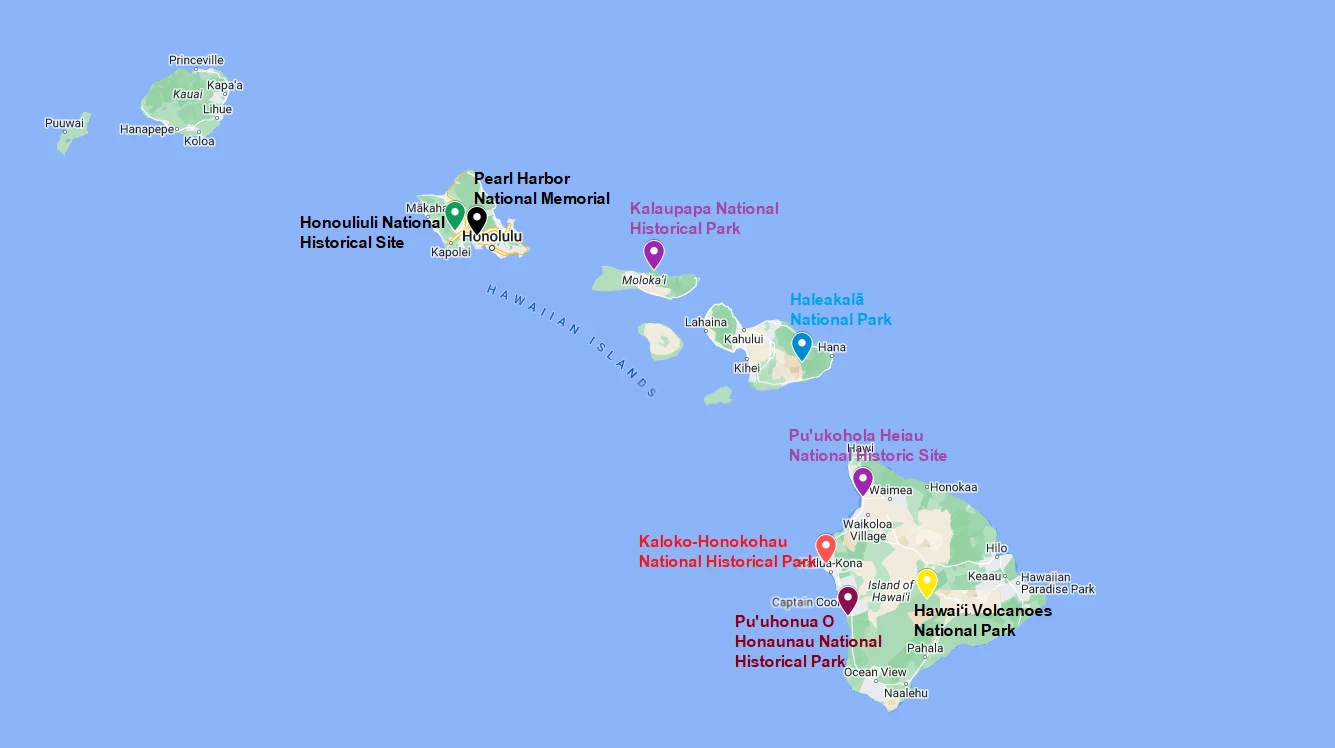
In this article I will write about these parks (infomation, things to do, weather). I also add Hawaii National Parks Map on Google map at the end of the article.
List of National Parks in Hawaii 2024
1. Haleakala National Park
Haleakalā National Park is located on the island of Maui in the state of Hawaii, USA. The park encompasses the Haleakalā Crater, a massive dormant volcano, and a significant portion of the surrounding area. Here’s some information about the park:
Phone: +1 808-572-4400
Things to Do:
- Sunrise or Sunset Viewing: One of the most popular activities is to watch the sunrise or sunset from the summit of Haleakalā. The views from the top of the crater are breathtaking.
- Hiking: There are numerous hiking trails within the park, ranging from short nature walks to more strenuous hikes that descend into the crater itself.
- Camping: There are two campgrounds within the park where visitors can camp overnight. Permits are required and reservations are recommended.
- Stargazing: The park offers excellent opportunities for stargazing due to its remote location and high elevation.
- Cultural Sites: Visitors can also explore cultural sites within the park, including ancient Hawaiian temples and petroglyphs.
Weather: The weather in Haleakalā National Park can vary significantly depending on the elevation. At the summit of Haleakalā, which reaches over 10,000 feet (3,000 meters) above sea level, temperatures can be quite cold, especially in the early morning and evening. It’s not uncommon for temperatures to be near or below freezing at night, so visitors should dress warmly if they plan to visit the summit for sunrise or sunset. In contrast, the temperatures at lower elevations within the park are typically much warmer and more moderate.
Overall, Haleakalā National Park offers visitors a unique opportunity to explore a diverse range of landscapes, from lush rainforests to otherworldly volcanic terrain, all within the stunning backdrop of Maui’s natural beauty.
2. Hawaii Volcanoes National Park
Hawaii Volcanoes National Park is located on the island of Hawaii (also known as the Big Island) in the state of Hawaii, USA. It is situated on the southeastern part of the island and encompasses two active volcanoes, Kīlauea and Mauna Loa. Here’s some information about the park:
Things to Do:
- Crater Rim Drive: This scenic drive takes visitors around the summit caldera of Kīlauea volcano, offering stunning views of the crater and surrounding landscapes.
- Hiking: There are numerous hiking trails within the park, ranging from easy walks to challenging treks. Popular hikes include the Kīlauea Iki Trail, which takes visitors across a crater floor, and the Devastation Trail, which showcases the aftermath of past volcanic eruptions.
- Volcano Viewing: Visitors can witness volcanic activity firsthand at various overlooks and viewpoints within the park. Depending on the current volcanic activity, visitors may be able to see lava flows, steam vents, and other volcanic features.
- Visitor Centers: The park has two visitor centers, the Kīlauea Visitor Center and the Jaggar Museum, where visitors can learn about the geology, history, and cultural significance of the park through exhibits and ranger-led programs.
- Cultural Sites: Hawaii Volcanoes National Park also contains significant cultural sites, including petroglyphs, ancient Hawaiian settlements, and sacred sites.
Weather: The weather in Hawaii Volcanoes National Park can vary depending on the elevation and time of year. At the higher elevations of Mauna Loa and the summit of Kīlauea, temperatures can be cooler, especially at night. However, temperatures at lower elevations within the park are typically warmer and more moderate.
It’s important to note that conditions within the park, especially regarding volcanic activity, can change rapidly. Visitors should check with park authorities for the latest updates and safety information before planning their visit.
3. Honouliuli National Historic Site
Honouliuli National Historic Site is located on the island of Oahu in the state of Hawaii, USA. It is situated in the Ewa district, near Waipahu, on the southern part of the island. Here’s some information about the site:
Location: Honouliuli National Historic Site is situated on the island of Oahu, specifically in the Ewa district, near Waipahu. The site is located inland, away from the coastline.
Things to Do:
- Historical Interpretation: Honouliuli National Historic Site preserves and interprets the history of the Honouliuli Internment Camp, which was used during World War II to detain Japanese American citizens and residents of Japanese ancestry. Visitors can learn about this dark chapter in American history through exhibits, interpretive programs, and guided tours.
- Visitor Center: The site features a visitor center where visitors can learn more about the history of the internment camp, view exhibits, and watch films documenting the experiences of those who were detained at Honouliuli.
- Memorial: There is a memorial at the site dedicated to the individuals who were interned at Honouliuli during World War II. Visitors can pay their respects and learn about the significance of the site in the context of civil liberties and human rights.
- Educational Programs: Honouliuli National Historic Site offers educational programs for visitors of all ages, including guided tours, lectures, and workshops focused on the history and legacy of the internment camp.
Weather: The weather on Oahu, including the area around Honouliuli National Historic Site, is generally warm and tropical year-round. Temperatures typically range from the mid-70s to mid-80s Fahrenheit (around 24-29 degrees Celsius). The island experiences a wet season from November to March, with occasional rain showers and increased humidity, while the dry season from April to October tends to be sunnier with lower humidity.
4. Kalaupapa National Historical Park
Kalaupapa National Historical Park is located on the island of Molokai in the state of Hawaii, USA. It is situated on the northern peninsula of Molokai and encompasses the historic settlement of Kalaupapa, which was once a leprosy (Hansen’s disease) settlement. Here’s some information about the park:
Things to Do:
- Historical Interpretation: Kalaupapa National Historical Park preserves and interprets the history of the Kalaupapa Peninsula, which served as a leprosy settlement from 1866 to 1969. Visitors can learn about the lives of the patients who were sent to live in isolation on the peninsula, as well as the work of Saint Damien and Saint Marianne Cope, who provided care and support to the residents.
- Guided Tours: The park offers guided tours led by National Park Service staff and trained guides, providing visitors with insights into the history, culture, and natural environment of the peninsula. These tours typically include visits to historic sites, such as Saint Damien’s Church and the gravesites of patients.
- Hiking: Visitors can explore the park’s hiking trails, which offer scenic views of the coastline and surrounding landscapes. The trails vary in difficulty and length, providing options for hikers of all skill levels.
- Wildlife Viewing: Kalaupapa National Historical Park is home to a variety of native plant and animal species, including seabirds, Hawaiian monk seals, and green sea turtles. Visitors may have the opportunity to observe wildlife along the coastline and in the park’s natural habitats.
- Cultural Programs: The park offers cultural programs and events that highlight the rich history and cultural heritage of the Kalaupapa Peninsula, including traditional Hawaiian music, dance, and storytelling.
Weather: The weather on the Kalaupapa Peninsula is generally warm and tropical year-round, with temperatures ranging from the mid-70s to mid-80s Fahrenheit (around 24-29 degrees Celsius). The area experiences a wet season from November to March, with occasional rain showers, while the dry season from April to October tends to be sunnier with lower humidity.
5. Kaloko-Honokōhau National Historical Park
Kaloko-Honokōhau National Historical Park is located on the western coast of the island of Hawaii, also known as the Big Island, in the state of Hawaii, USA. Here’s some information about the park:
Things to Do:
- Cultural Sites: The park preserves and interprets ancient Hawaiian cultural sites, including fishponds, heiaus (temples), petroglyphs, and house sites. Visitors can explore these sites and learn about the traditional practices and lifestyles of the native Hawaiian people.
- Hiking: The park features several hiking trails that meander through coastal lava fields, offering opportunities to observe native plants and wildlife. The Ala Kahakai National Historic Trail also passes through the park, providing additional hiking opportunities.
- Beach Activities: The park includes several beautiful beaches where visitors can swim, snorkel, or simply relax and enjoy the scenery. Kaloko Fishpond is a popular spot for birdwatching and observing native Hawaiian waterbirds.
- Cultural Demonstrations: The park occasionally hosts cultural demonstrations and events where visitors can learn about traditional Hawaiian arts, crafts, and practices.
- Visitor Center: The park has a visitor center where visitors can learn about the history, culture, and natural resources of the area through exhibits, ranger-led programs, and informational materials.
Weather: The weather at Kaloko-Honokōhau National Historical Park is typically warm and sunny, with temperatures ranging from the mid-70s to mid-80s Fahrenheit (around 24-29 degrees Celsius) year-round. The park experiences a dry season from April to October and a wet season from November to March, with occasional rain showers.
6. Pearl Harbor National Memorial
Pearl Harbor National Memorial is located on the island of Oahu in the state of Hawaii, USA. It commemorates the December 7, 1941, attack on Pearl Harbor by the Imperial Japanese Navy, which led to the United States’ entry into World War II. Here’s some information about the memorial:
Things to Do:
- USS Arizona Memorial: The USS Arizona Memorial is one of the main attractions at Pearl Harbor. It is built over the sunken wreckage of the USS Arizona battleship, which was destroyed during the attack. Visitors can take a boat ride to the memorial and learn about the events of December 7, 1941, and the lives lost during the attack.
- USS Missouri: The USS Missouri, also known as the “Mighty Mo,” is a historic battleship that played a significant role in World War II. It is docked near the USS Arizona Memorial and is open for guided tours. Visitors can explore the ship’s decks and learn about its history.
- USS Bowfin Submarine Museum: The USS Bowfin Submarine Museum and Park is located adjacent to Pearl Harbor and features the USS Bowfin, a World War II-era submarine that is open for tours. The museum also houses exhibits related to submarines and naval history.
- Pacific Aviation Museum Pearl Harbor: The Pacific Aviation Museum Pearl Harbor is located on Ford Island, within the Pearl Harbor National Memorial. It showcases a collection of historic aircraft and exhibits related to aviation history in the Pacific theater of World War II.
- Visitor Center: The Pearl Harbor Visitor Center serves as the entry point for visitors to the memorial. It features exhibits, artifacts, and multimedia presentations that provide an overview of the events leading up to and following the attack on Pearl Harbor.
Weather: The weather at Pearl Harbor National Memorial is typically warm and tropical year-round, with temperatures ranging from the mid-70s to mid-80s Fahrenheit (around 24-29 degrees Celsius). The area experiences occasional rain showers, especially during the wet season from November to March.
7. Puuhonua o Hōnaunau National Historical Park
Puʻuhonua o Hōnaunau National Historical Park, also known as the Place of Refuge, is located on the western coast of the island of Hawaii, also known as the Big Island, in the state of Hawaii, USA. Here’s some information about the park:
Things to Do:
- Cultural Sites: The park preserves and interprets an ancient Hawaiian cultural site known as a puʻuhonua, or place of refuge. Visitors can explore the grounds of the puʻuhonua and learn about its significance in Hawaiian history and culture. The site includes reconstructed temples, royal fishponds, and other archaeological features.
- Historical Interpretation: Park rangers and cultural guides offer interpretive programs and guided tours that provide insights into the history, traditions, and practices of the native Hawaiian people who once lived in the area.
- Hiking: The park features hiking trails that meander through coastal landscapes, offering opportunities to observe native plants, wildlife, and archaeological sites. The Ala Kahakai National Historic Trail also passes through the park, providing additional hiking opportunities.
- Snorkeling and Swimming: The park’s coastline includes a protected bay with clear waters that are ideal for snorkeling and swimming. Visitors can explore coral reefs, marine life, and underwater archaeological sites.
- Picnicking and Relaxation: The park has picnic areas and scenic overlooks where visitors can enjoy a meal, relax, and take in views of the surrounding landscapes and coastline.
Weather: The weather at Puʻuhonua o Hōnaunau National Historical Park is typically warm and sunny, with temperatures ranging from the mid-70s to mid-80s Fahrenheit (around 24-29 degrees Celsius) year-round. The area experiences a dry season from April to October and a wet season from November to March, with occasional rain showers.
8. Puukoholā Heiau National Historic Site
Puʻukoholā Heiau National Historic Site is located on the northwest coast of the island of Hawaii, also known as the Big Island, in the state of Hawaii, USA. Here’s some information about the site:
Things to Do:
- Puʻukoholā Heiau: The site is centered around Puʻukoholā Heiau, which is a massive stone temple constructed in the late 18th century by King Kamehameha I. Visitors can explore the heiau and learn about its history, significance, and construction techniques.
- Visitor Center: The site has a visitor center where visitors can learn about the history, culture, and significance of Puʻukoholā Heiau through exhibits, displays, and interpretive programs.
- Cultural Demonstrations: Park rangers and cultural practitioners occasionally offer demonstrations and educational programs that showcase traditional Hawaiian arts, crafts, and practices related to the heiau and Hawaiian culture.
- Hiking: The site features hiking trails that meander through coastal landscapes and offer scenic views of the surrounding area. The Ala Kahakai National Historic Trail also passes through the site, providing additional hiking opportunities.
- Picnicking and Relaxation: The site has picnic areas and scenic overlooks where visitors can enjoy a meal, relax, and take in views of the surrounding landscapes and coastline.
Weather: The weather at Puʻukoholā Heiau National Historic Site is typically warm and sunny, with temperatures ranging from the mid-70s to mid-80s Fahrenheit (around 24-29 degrees Celsius) year-round. The area experiences a dry season from April to October and a wet season from November to March, with occasional rain showers.
National Parks in Hawaii Map
Now you can answer the question “how many national parks in hawaii?” Hawaii has 8 national parks.
Tag: List of National Parks in Hawaii, Hawaii National Parks, List of National Parks in Hawaii 2024, national parks in Hawaii map, Hawaii national parks map, national parks in Hawaii list
Read more:

